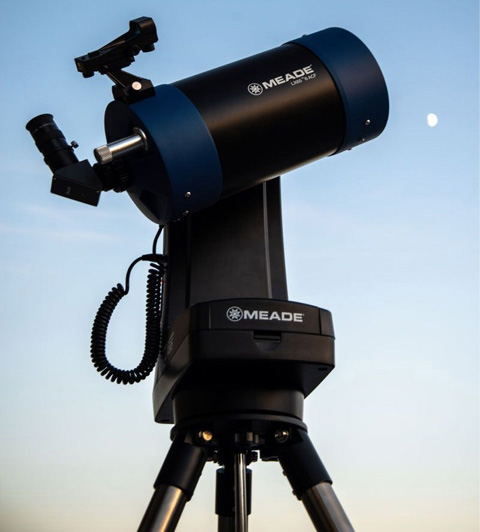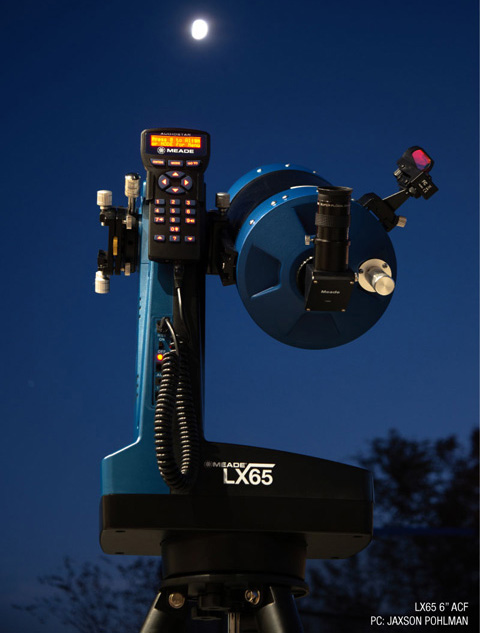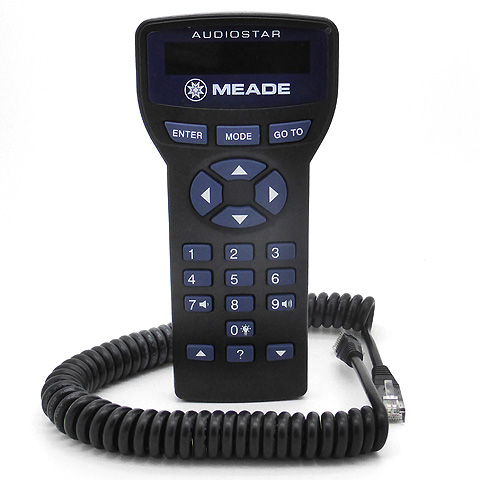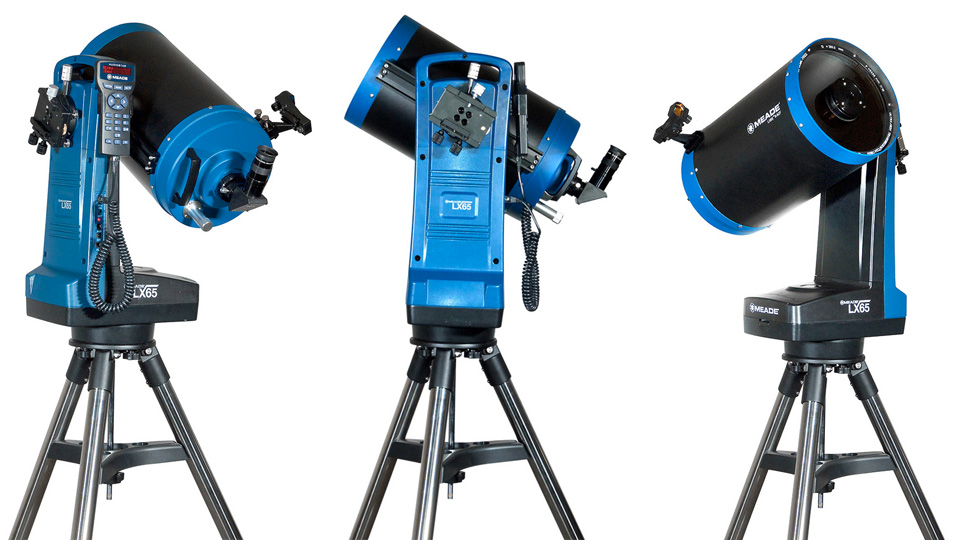Introduction
The Meade LX65 series represent Meade Instruments' latest telescopes that have been designed to make the universe accessible to both beginners and seasoned observers at a moment’s notice.
The LX65 series telescopes are newly designed, compact and sturdy and come with the speech enabled Meade AudioStar hand controller with GOTO functionality. The LX65 ACF combines a sophisticated level of advanced features and uses Meade’s premium ACF optics.
In addition, the LX65 comes with two saddles giving the ability to hold two optical tubes (up to 6.8Kg and 3.2Kg respectively) at the same time, for a chance to observe deep sky and Solar System objects in both wide field and close up.
The LX65 ACF comes in 6-inch and 8-inch apertures and is an ideal high resolution visual observing instrument also very well suited for planetary, Lunar and Solar imaging with an appropriate full aperture Solar filter.

Meade LX65 6-inch ACF telescope. Credit: Jaxson Pohlman.
Meade Advanced Coma Corrected (ACF) optics
The heart of any telescope is its optics. Meade’s Advanced Coma Free optics (ACF) coupled with Meade’s Ultra-High Transmission Coatings (UHTC) deliver the ultimate in premium optics in terms of high transparency and high-resolution optics.
The ACF design offers exceptional optical performance across the whole field of view unlike legacy SCT designs where coma is present and readily detectable as you move away from the centre of the field of view making stars appear as ‘V’ shapes and significantly reducing detail when observing or imaging extended targets like the Moon and numerous other deep sky objects.
Using this Meade exclusive optical design, making ACF optics equal to Ritchey-Chrétien systems, ACF achieve aplanatic performance - with a flatter field, reduced astigmatism and no diffraction spikes.
The ACF design realises this partially via the use of aspherical reflective optics and without complex corrector lenses arrangements that are subject to light loss and misalignment which can lead to optical aberrations and extended cooling times.

Meade LX65 telescope. Credit: Jaxson Pohlman.
AudioStar hand controller
The AudioStar handset features audio files and an internal speaker. This computerised celestial object locating system plugs into the telescope's handset port allowing for quick telescope alignment.
Once aligned with the sky, the AudioStar is ready to take you to any object in the over 30,000 object database. In addition to GOTO and auto-tracking capability the AudioStar offers a wide array of recreational and educational functions such as multiple Guided Tours, digital positional readouts, the ability to link with a PC or tablet using an optional cord/wireless adapter and software.
After alignment, GOTO telescopes are very attractive as they can automatically locate and then track Celestial objects including planets, the Moon, stars, galaxies and nebulae among others.
The AudioStar hand controller comes with Astronomer Inside, with over five hours of audio facts and history relating to many of the objects in the AudioStar's database making it an educational.

AudioStar handbox controller.
Easy Alignment
To Star-align your LX65 telescope, enter your site information find and level North, and AudioStar’s Easy Align automatically picks two Alignment Stars for you and places them in the viewfinder. Centre them in the eyepiece to fine tune your telescope’s alignment and you are ready to explore the universe.
Transportability
LX65 telescopes are easy to transport since they can be easily disassembled within a couple of minutes and without tools in their three separate parts namely, tripod (4Kg), mount (9Kg) and optical tube (4.2-5Kg).
Accessories
The LX65 6-inch and 8-inch ACF telescopes come with a 26mm eyepiece and will require 8 C-type battery cells or alternative power supply to operate them.
Otherwise, as you become familiar with your telescope and astronomy in general you may decide to extend the capabilities of the LX65 with the addition of various accessories e.g., a dew shield to protect the optics from condensation, eyepieces for different magnifications, Moon and planetary filters, barlow lenses, cameras etc.

LX65 6-inch ACF telescope with additional optical tube.
Powering the LX65
You will need electric power to operate and use the LX65 that can be powered from 8 C-type battery cells or a good quality 12VDC 3A mains power supply. Alternatively, a rechargeable power tank with a 12VDC output (pin positive) can be used to power the LX65.
Eyepieces
A minimum three eyepieces should be chosen to start so as to provide minimum, average, and close to maximum magnifications. You could fill the gaps as you acquire more eyepieces and as the need arises. What eyepieces you add depends on your actual telescope and the maximum magnification it is capable of. Higher quality eyepieces will deliver crisper images, wider fields of view and a brighter view depending on the quality of the optics, number of lenses within the eyepiece and coatings applied. Everything being equal, Fully Multi Coated (FMC) eyepieces will offer the best performance.

Meade LX65 8-inch ACF.
The most powerful eyepiece for the LX65 ACF 6-inch and 8-inch optical tubes would be a 6.2mm focal length eyepiece. Since the telescope comes with a 26mm Super Plossl eyepiece, an 8mm, 12mm and 40mm focal length eyepieces would all be good candidates.
For more information on eyepieces, magnifications and fields of view please refer to the "Choosing your first telescope" article in the Links section below.
Moon and planetary filters
A 13% transparency Moon filter will be necessary to observe the Moon with either the 6-inch or 8-inch LX65 optical tubes.

Moon and planetary filters.
Colour filters are required to bring out additional detail on the surface of planets that would otherwise be very difficult or impossible to see. For example, filters will bring out contrast in the clouds of Jupiter and Saturn, show fine detail on the surface of Mars and make it easier to observe Venus. When you first use colour filters you will notice some difference but with practice you will see a lot more detail, especially at higher magnifications.
Barlow lenses & focal reducers
The optical characteristics of a telescope can be changed with certain accessories such as barlow lenses that increase a telescope’s focal length and focal reducers that reduce a telescope’s focal length but these are outside the scope of this article.
Planetary/Lunar cameras
Meade supplies the LPI-G video cameras that can used to observe in real-time and also capture images and video of the Moon and planets.
With an appropriate full aperture Solar filter, you would also be able to capture images of the Sun.
Remote control
The LX65 can be connected and controlled via a PC, iOS or Android smartphone/tablet.
To directly connect an LX65, to a PC you will need the Meade #505 cable and USB to Serial adapter. For more information, please refer to the article headed "Remote control for Meade telescopes" article in the Links section below.
Alternatively, the LX65 can be controlled from an Apple iOS or Android device for which you will need the optional Safari 6 Plus/Pro software and Meade Stella WiFi adapter or similar WiFi adapter.
Related topics:
article, LX65






